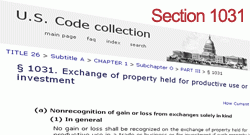BLOG
Now is the time to think about 1031 exchanges

Why put a tax-deferral program in place when taxes are low?
Lessors and other savvy owners of business assets understand the financial benefits of a well-managed, programmatic 1031 Like-Kind Exchange (LKE) system. But "bonus depreciation," a currently low capital gains tax rate, a reduced effective overall tax rate resulting from reduced corporate profits, and the prospect of increasing tax rates in the future are all causing asset owners to question whether a 1031 LKE program makes sense for them at this time. The simple answer - regardless of current taxable status - is probably a resounding "yes."
Bonus depreciation is intended to provide additional incentive for investment in capital assets, just as the original Section 1031 provisions were intended to do when they were instituted in the 1920s. These are effectively complimentary incentives, not competing ones. Bonus depreciation, by its very nature, allows the owner's tax basis to be written down more aggressively, meaning that the "gap" between fair market value and depreciated basis grows more quickly. This gap is the taxable income an asset owner realizes when the asset is sold. Consequently, while the owner realizes a current tax benefit from the acceleration of depreciation, upon sale of that asset the "benefit" is partially repaid through tax on the "gain" if the sale price exceeds the depreciated basis - unless, of course, the owner replaces that asset with a like-kind asset, and defers the tax through a 1031 exchange.
Another feature of the 1031 LKE allows for "step-in-the-shoes" depreciation, meaning the replacement asset enjoys the carry-over basis, effectively deferring the tax and leaving the cash available to the owner for purchase of the replacement asset. Fleet owners, lessors with a portfolio of assets, and companies constantly replacing capital assets used in their business can enjoy both the accelerated depreciation and the LKE benefits that convert tax liability to cash for investment.
But what if the owner's tax rate is lower today than it is expected to be in the future? Does it make sense to pay the tax today instead of deferring into a higher tax rate environment?
This question can be answered theoretically, but working with an LKE expert to determine the specifics of each situation is advisable. In general, however, deferring the tax today by replacing the sold asset with a like-kind asset through a 1031 exchange, generates a higher financial return. One of the basic tenets of the US leasing industry, where nearly $650 billion of assets are leased and financed annually, illustrates that a dollar of tax paid today is more expensive than a dollar of tax paid "tomorrow." And unless the taxpayer plans to liquidate or go out of business, the opportunity to employ successive LKE's effectively allows an indefinite deferral of the tax liability for so long as replacement assets are being acquired.
Regardless of the amount of deferral, any amount not paid in current taxes is, effectively, another source of cash. At a time when credit tightening, widening spreads, and increasingly-burdensome covenants and conditions characterize the capital markets, a careful cost-of-capital analysis will illustrate another real benefit of an LKE. Some owners measure the value of their LKE not as a tax deferral, but by its impact on their real cost of funds - the avoided cost of issuing debt or equity is significant, and by preserving the cash that otherwise leaves the company in the form of taxes paid, owners can re-deploy that cash to acquire replacement assets at a lower effective cost. Lower effective cost of assets then translates into greater operating efficiencies, which improves margins and profitability or makes the enterprise more competitive in the market. Either way, tapping the cash "hidden" in assets being sold and replaced is by all measures a good thing.
Finally, there's considerable value in putting in place an asset management process to track multiple depreciation streams on a single asset; match assets sold and acquired to optimize the like-kind opportunities; compare high-tax-basis assets with lower-basis assets when deciding which to sell (to optimize after-tax proceeds) - the process itself can help make an enterprise more efficient. Designed to optimize the LKE deferral, a system that also provides asset management information can be a valuable differentiator for day-to-day operations.
So for those business asset owners who think the current tax environment may not be the right time to put in place a comprehensive, programmatic 1031 LKE process supported by systems and professionals, there may actually never be a better time. Ski slope operators use the time when there's no snow on the slopes to do the sub-surface and trail maintenance that will make their revenue season better. Fire marshals conduct their safety inspections and recommend improvements when buildings are not on fire. Farmers don't wait for the infestation to protect crops from pests. And taxpayers should seize the opportunity of putting systems in place even when the immediate impact may not be as great as they should expect it will one day be.
